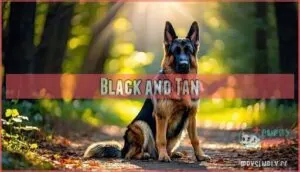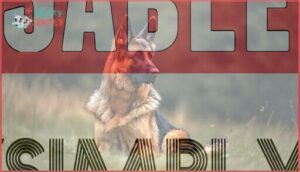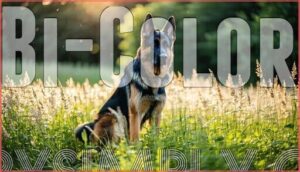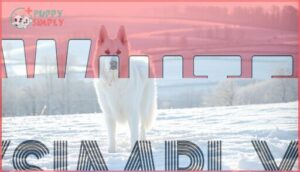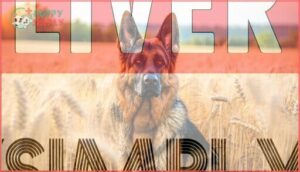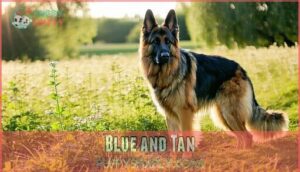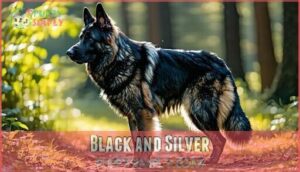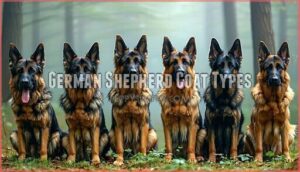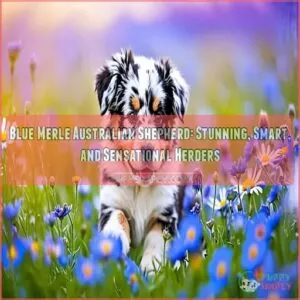This site is supported by our readers. We may earn a commission, at no cost to you, if you purchase through links.

You’ll find these loyal companions sporting everything from rich mahogany tones to rare silver markings. The most common pattern features a dark saddle across the back with lighter legs and chest, though some dogs display the beautiful sable coloring where individual hairs have multiple color bands.
While white German shepherds exist, they’re not recognized in show rings. Blue and liver colors occur but are less common.
Each color variation carries the same intelligence and devotion that makes these dogs exceptional partners. Understanding these patterns reveals fascinating insights about genetics and breeding practices that shape your future companion’s appearance.
Table Of Contents
- Key Takeaways
- German Shepherd Colors
- Coat Color Variations
- Health Considerations
- Choosing Right Color
- Rare German Shepherd Colors
- German Shepherd Coat Types
- Frequently Asked Questions (FAQs)
- What is the rarest color for a German Shepherd?
- What color German Shepherd is the most expensive?
- What color German Shepherds are recognized by AKC?
- What are the 7 classifications of German Shepherds?
- Do German Shepherd colors affect temperament or behavior?
- Can German Shepherd coat colors fade with age?
- Are certain colors more prone to shedding?
- Do different colors require different grooming techniques?
- Which German Shepherd colors are most expensive?
- Conclusion
Key Takeaways
- You’ll find 11 AKC-recognized German Shepherd colors, from classic black and tan to rare variations like Isabella and panda markings, with sable being the original shepherd coloring that creates a wild, wolf-like appearance.
- Rare colors like blue, liver, and Isabella can carry health risks, including color dilution alopecia, sun sensitivity, and skin problems, so you should prioritize health screening over chasing uncommon colors when selecting a puppy.
- Your German Shepherd’s coat color doesn’t affect temperament or intelligence – whether you choose black and tan, sable, or bi-color, you’ll get the same loyal, devoted companion with exceptional working abilities.
- Coat type matters more than color for grooming needs – double coats require seasonal maintenance, long coats need daily brushing to prevent matting, and plush coats fall somewhere between standard and long varieties in care requirements.
German Shepherd Colors
You’ll discover that German Shepherds come in 11 AKC-recognized colors, from the classic black and tan to rare variations like Isabella and panda markings.
Understanding these color genetics helps you choose the right puppy and know what to expect as your dog’s coat develops from puppyhood to adulthood, which is a crucial aspect of German Shepherds.
Standard Colors
When choosing a German Shepherd, you’ll find the American Kennel Club recognizes eleven standard colors that dominate breed populations worldwide.
Black and tan reigns supreme in color prevalence, while breed standards favor rich, solid pigmentation over washed-out variations for show preferences.
As highly intelligent dogs, German Shepherds are known for their trainability.
Standard German Shepherd Colors:
- Black and Tan – The classic combination with deep black saddle markings over tan base, representing traditional genetic basis
- Black and Red – Features rich mahogany-red base with black overlay, prized for its striking contrast
- Sable – Original shepherd coloration ranging from light sandy to dark, almost black tipping
- Solid Black – Pure black coat without tan points, less common but AKC-recognized
- Bi-Color – Mostly black with minimal tan markings on legs and chest
Rare Colors
Beyond standard variations, you’ll discover several rare colors that make German Shepherds stand out.
Isabella genetics produce the rarest lilac shade through dilution genes combining blue and liver traits.
Panda controversy surrounds black-and-white patterns that kennel clubs don’t recognize.
Brindle patterns create tiger-like stripes but face breeding restrictions.
Blue german shepherd and liver german shepherd colors carry potential health concerns, while panda german shepherd markings remain genetically fascinating yet controversial.
Color Genetics
Understanding German Shepherd colors requires grasping the genetic blueprint behind each variation.
Color genetics hold the key to understanding your German Shepherd’s unique coat pattern and future appearance changes.
The Agouti Gene controls sable patterns, while the B Locus determines black pigmentation through dominant and recessive genes.
Sable dominance makes it the most common working line color, but dilution genes create rare blues and livers.
ASIP influence shapes the classic saddle pattern you recognize.
Genetic mutations occasionally produce unique variations like panda markings, proving coat genetics constantly evolve.
Coat Color Variations
You’ll discover that German Shepherds display four primary coat color variations, each with distinct characteristics and genetic backgrounds.
These variations include the classic black and tan pattern, the natural sable coloring, the striking bi-color combination, and the rare white coat that stands out from traditional standards.
Black and Tan
You’ll recognize black and tan as the most common german shepherd colors, making up the majority of the breed worldwide.
This classic appearance features a rich tan base with distinctive black markings across the saddle, face, and legs.
The genetics explained show this pattern comes from the recessive ‘at’ gene, which creates the traditional look you see in breeding standards.
During puppy development, these coat colors often darken substantially from their initial lighter shades, showcasing a notable change in their classic appearance.
Sable
Every sable German shepherd showcases the breed’s original coloring, with individual hairs banded in multiple colors creating a wild, wolf-like appearance.
You’ll find sable variations ranging from light sandy tones to dark, almost black coats, with red sable being particularly striking.
Sable genetics make this the dominant color pattern, explaining its popularity in working lines where function trumps fashion.
Sable breeding often produces puppies that dramatically change color as they mature, keeping you guessing until adulthood, which is a result of the sable genetics and the fact that function is key in these lines.
Bi-Color
Bi-color German Shepherds showcase a striking coat pattern where black dominates most of the body, with tan markings appearing only on the legs, chest, and face.
This bicolor german shepherd variation results from specific genetic combinations at the ASIP gene locus, creating minimal marking distribution compared to traditional black and tan patterns.
Breeding bi-color dogs requires careful genetic planning to maintain these distinctive bicolor variations while preserving the breed’s structural integrity and temperament standards.
White
White German Shepherds carry a recessive trait that creates their stunning snow-white coats, making them stand out among their darker counterparts.
While these dogs face AKC standards disqualification from conformation shows, they’re still registered and compete in obedience events.
- Pure white coat with dark eyes and nose
- Requires frequent baths to prevent staining
- May have higher risk of deafness and skin sensitivity
Though white genetics don’t indicate health problems, ethical breeding practices remain essential for these beautiful dogs.
Health Considerations
When considering a German Shepherd’s coat color, you’ll want to understand that certain colors can carry health risks that responsible breeding practices help minimize.
Some rare colors like white, liver, and blue may be linked to specific health concerns that you should discuss with reputable breeders before making your choice, as responsible breeding practices help minimize these risks.
Breeding Considerations
When breeding German Shepherds, you’ll want to prioritize genetic diversity over specific colors.
Ethical breeding focuses on health screening and temperament traits rather than chasing rare colors.
Understanding color inheritance helps you predict outcomes – dominant genes like sable typically override recessive genes like blue or liver.
Always follow AKC standards and avoid breeding solely for uncommon colors, as this can compromise the breed’s overall health and working ability. This approach can help reduce the risks of breed-specific diseases.
Coat Color Health Risks
Some coat colors carry hidden health risks that you’ll want to understand before making your choice. Color-linked ailments affect certain variations more than others, with pigmentation deficiencies creating unexpected challenges for your German Shepherd’s wellbeing.
Here are five key coat color health considerations:
- Color dilution alopecia affects blue, liver, and Isabella dogs, causing progressive hair loss and skin problems
- Sun sensitivity increases in liver-colored dogs due to reduced melanin protection
- Genetic predispositions become more common when breeding focuses on rare colors over health
- UV damage prevention becomes critical for dogs with lighter pigmentation
- Coat care impact varies substantially between standard and dilute color variations
Dilute colors like blue and liver carry higher risks for immune system weakness and skin disorders. These dogs need extra sun protection and specialized grooming routines to maintain their health and appearance throughout their lives.
Selective breeding can reduce overall genetic diversity, increasing the risk of hereditary diseases.
White German Shepherds
Despite public perception linking white genetics to health problems, white German Shepherds don’t face unique medical risks beyond standard breed concerns.
Their AKC exclusion stems from breed standards, not health issues. These dogs require regular grooming needs due to their bright coat showing dirt easily.
The breed’s health concerns, including hip dysplasia and allergies, mirror traditional German shepherd colors.
The breed’s history includes Captain Max von Stephanitz, who established the German Shepherd breed, highlighting the German Shepherd breed.
Liver German Shepherds
Unlike other rare german shepherd colors, liver variations stem from a recessive gene at the B locus, requiring both parents to carry it.
You’ll notice liver German Shepherds display chocolate-brown coats with amber eyes and brown noses.
Liver health mirrors standard German Shepherds, though liver breeding remains limited due to show preferences.
This liver genetics combination creates stunning coat colors while maintaining the breed’s beloved temperament and working abilities, resulting in a unique appearance with liver variations.
Choosing Right Color
When selecting a German Shepherd’s coat color, your personal preference matters most since no single color indicates better health or temperament.
Consider your lifestyle, living environment, and maintenance commitment, as some colors like white may require more frequent grooming to prevent stains.
Personal Preference
Your heart’s desire matters most when choosing your German Shepherd’s coat color, and aesthetics matter deeply in this decision.
While breed standards influence color popularity, your individual expression through color preferences reflects your personality and lifestyle.
Consider how your favorite color connects with your dog’s appearance, as color psychology suggests certain hues boost color-related self-esteem and enhance your pet’s natural color-related charm.
Lifestyle and Environment
Beyond personal taste, your living situation plays a big role in coat color selection.
Climate impact affects how certain colors handle weather conditions, while urban vs. rural settings present different challenges.
- Urban environments: Lighter colors show dirt faster, requiring more frequent baths
- Rural settings: Darker coats camouflage outdoor debris better during adventures
- Activity levels: High-energy lifestyles mean more grooming needs regardless of color
- Sun exposure: Prolonged outdoor time causes color fading, affecting coat health without proper care
Balanced diet, regular exercise, and routine grooming maintain vibrancy across all variations.
Understanding their socialization and training is also essential for responsible pet ownership.
Factors to Consider
Beyond simply picking your favorite shade, several key factors should guide your German Shepherd color choice.
Consider Color Cost – rare colors like Isabella command premium prices, while standard black and tan remain affordable.
Research Breeder Ethics and verify AKC Standards compliance if showing matters.
Genetic Testing guarantees healthy bloodlines, regardless of Color Popularity.
Remember, coat colors don’t determine temperament – focus on health and breeding quality over flashy German Shepherd colors.
Rare German Shepherd Colors
You’ll discover some truly unique German Shepherd colors that exist outside the standard breed guidelines, though many aren’t recognized by major kennel clubs.
These rare variations like panda, liver, blue and tan, and black and silver showcase the breed’s fascinating genetic diversity, even if they’re considered faults in show rings, with rare being a key aspect of their uniqueness.
Panda
The panda german shepherd represents one of the most fascinating genetic mutation stories in canine history.
This striking white spotting pattern emerged from a single dog in 2000, creating a rare variation that’s captured hearts worldwide.
While AKC recognition remains elusive due to breed standards, panda genetics continue fascinating researchers.
Breeding Panda German Shepherds requires careful consideration, as health concerns arise when two carriers mate.
Despite panda popularity growing among enthusiasts, this genetic mutation remains extraordinarily rare in german shepherd colors.
Liver
You’ll find liver German Shepherds showcase a rich, reddish-brown coat that’s truly striking.
This liver coloration comes from recessive B locus genetics, requiring both parents to carry the liver gene for offspring to display this rare variation.
Their distinctive liver nose and amber eyes complement their deep chocolate coat perfectly.
While liver breeding remains limited due to AKC show restrictions, these dogs maintain excellent health and temperament, making liver rarity a purely aesthetic consideration rather than a functional concern.
Blue and Tan
Blue and tan German shepherds showcase a stunning steel-blue or slate-gray coat through genetic inheritance of recessive dilution genes.
While the AKC standards consider blue a serious fault, these dogs maintain exceptional intelligence and working abilities.
Color rarity doesn’t affect breed popularity among enthusiasts who appreciate unique coat colors.
Health concerns like Color Dilution Alopecia occasionally occur but remain manageable in most blue german shepherd lines, which is a key aspect of their working abilities.
Black and Silver
Another striking variation you’ll encounter is the black and silver german shepherd, where silver masking creates a sophisticated appearance that’s caught many dog lovers’ attention.
This coat pattern features silver or gray coloration alongside black markings, making these dogs stand out from typical german shepherd colors.
Here’s what makes black and silver coats unique:
- Silver Masking – The silver replaces traditional tan markings, creating a cooler color palette
- Pattern Intensity – Silver can range from light gray to deep charcoal depending on genetics
- Breeding Challenges – Requires specific recessive genes from both parents to produce offspring
- Show Ring – AKC recognizes this as acceptable but less common than standard variations
- Color Popularity – Growing demand among pet owners seeking distinctive coat colors
These purebred dogs maintain the same intelligence and working ability as any black german shepherd, just with that eye-catching silver twist.
German Shepherd Coat Types
While German Shepherds are famous for their striking colors, their coat type plays an equally important role in their appearance and care needs.
You’ll find four main coat types in this breed: double coat, long coat, plush coat, and wire coat, each with distinct characteristics that affect grooming requirements and weather protection.
Double Coat
Most German Shepherds possess a double coat system that naturally regulates their body temperature throughout the year.
This dual-layer structure consists of a dense undercoat beneath longer guard hairs, creating excellent insulation against weather extremes.
The double coat, similar to that of Springer Spaniels, offers insulation and protection.
| Coat Layer | Function | Grooming Frequency |
|---|---|---|
| Outer Guard Hairs | Weather protection, dirt resistance | Weekly brushing |
| Dense Undercoat | Temperature regulation, insulation | Daily during shedding seasons |
| Combined System | Complete weather adaptation | Year-round maintenance required |
Double coat function involves seasonal changes where undercoat density increases in winter and decreases in spring.
Shedding frequency peaks twice yearly, requiring intensive grooming needs during these periods.
Regular coat care prevents matting and maintains healthy german shepherd colors across all color variations.
Long Coat
Your German Shepherd’s long coat genetics create stunning coat variations that require dedicated grooming long coats maintenance.
These beautiful coat types aren’t eligible for show eligibility in many competitions, but they’re breathtaking nonetheless.
You’ll need consistent brushing for matting prevention since longer fur tangles easily.
A specialized grooming tool can help manage their coat.
Shedding concerns increase with longlength coat varieties, making regular grooming essential for managing loose fur around your home, which is a significant concern.
Plush Coat
Two key features make plush coats special among german shepherd colors and coat variations.
You’ll notice this coat type sits between standard double coats and long coats, creating a medium-length appearance that’s soft to touch.
Plush coat genetics produce thicker, denser fur that requires specific grooming techniques, such as regular brushing to prevent matting while maintaining coat health.
Regular brushing prevents matting while maintaining coat health, and plush coat standard allows this variation in shows, unlike some coat color restrictions.
Specialized tools like a plush coat brush can assist with this grooming.
Wire Coat
Wire coats represent the rarest coat type in German Shepherds, occurring when Wire Coat Genetics create a harsh, weather-resistant outer layer that’s completely different from standard coat colors.
You’ll find these dogs need specialized care since Wire Coat Rarity makes finding proper grooming techniques challenging.
Here’s what you should know about this unique German Shepherd coat variation:
- Wire Coat Health requires regular brushing to prevent matting and skin irritation
- Grooming Wire Coats demands specific tools designed for coarse, wiry textures
- Breed Standard Influence means wire coats aren’t recognized in most dog breed competitions
Maintaining these coats often requires a specialized grooming brush.
Frequently Asked Questions (FAQs)
What is the rarest color for a German Shepherd?
Picture a breeder’s surprise when their champion bloodline produced a stunning Isabella puppy – this lilac-colored gem represents German Shepherd rarity at its finest.
Isabella’s the rarest color you’ll find, created when blue and liver dilution genes combine to produce an almost mystical pale purple-gray coat that’s truly one-of-a-kind, showcasing a unique example of rarity.
What color German Shepherd is the most expensive?
Isabella German Shepherds cost the most, ranging from $2,500 to $5,000 or more. You’ll pay premium prices for this rare lilac-colored coat that results from combining blue and liver dilution genes together.
What color German Shepherds are recognized by AKC?
The AKC recognizes 11 official German Shepherd colors: Bi-Color, Black, Black & Cream, Black & Red, Black & Silver, Black & Tan, Blue, Gray, Liver, Sable, and White for registration purposes.
What are the 7 classifications of German Shepherds?
Surprisingly, your question about seven German Shepherd classifications isn’t backed by breed standards.
German Shepherds actually have two main categories: working line and show line, with each having sub-categories.
These aren’t seven distinct classifications, but rather a simpler structure based on breeding purposes.
Do German Shepherd colors affect temperament or behavior?
No, German Shepherd coat color doesn’t affect temperament or behavior.
Your dog’s personality depends on genetics, training, and socialization – not whether they’re black, tan, sable, or any other color variation.
Can German Shepherd coat colors fade with age?
Yes, your German Shepherd’s coat can fade with age due to sun exposure, seasonal changes, and natural aging processes.
You’ll notice colors become lighter or duller, especially in sables and darker shades over time.
Are certain colors more prone to shedding?
No, shedding amount doesn’t vary by coat color in German Shepherds.
All colors shed equally since they share the same double-coat structure and genetics, regardless of whether you’ve got a classic black and tan or rare sable.
Do different colors require different grooming techniques?
Color-coordinated care comes naturally! You’ll use identical grooming techniques for all German Shepherd colors – regular brushing, bathing, and nail trimming remain consistent.
White coats might need slightly more frequent baths to prevent staining, but the fundamental approach stays the same, with regular brushing being a key part of the care routine.
Which German Shepherd colors are most expensive?
Rare colors command premium prices, with Isabella fetching $2,500-$5,000+ as the rarest shade. Sable costs $1,000-$2,000, while classic black and tan runs $800-$1,500, making rarity the key price driver.
Conclusion
Like a painter’s palette filled with endless possibilities, German shepherd colors offer remarkable diversity beyond the classic black and tan.
Whether you’re drawn to the striking sable pattern, elegant bi-color markings, or rare variations like panda or liver, each German shepherd colors combination brings unique beauty to these devoted companions.
Remember that temperament and health matter more than appearance when choosing your furry friend.
Every color variation carries the same loyal heart and sharp intelligence that makes German shepherds exceptional family guardians and lifelong partners, with each one being a unique companion.
- https://www.reddit.com/r/germanshepherds/comments/qcrsam/how_do_you_all_respond_when_people_tell_you_that/
- https://www.ukcdogs.com/german-shepherd-dog
- https://baiuland.it/genetic-colour-transmission-german-shepherd-dog/
- https://www.vomgeliebtenhaus.com/colors-of-a-german-shepherd-dog
- https://regisregal.com/what-is-the-rarest-color-of-german-shepherd/

